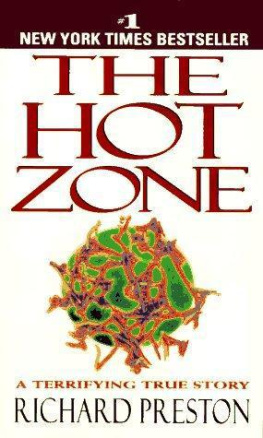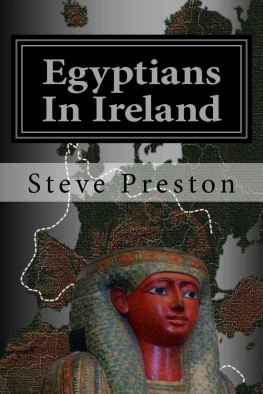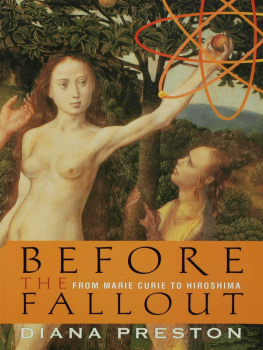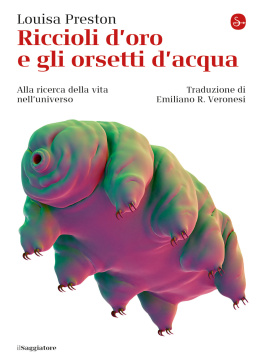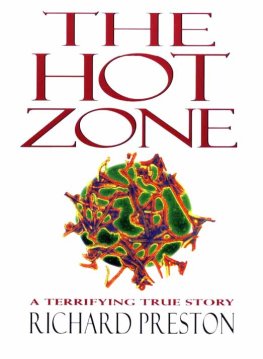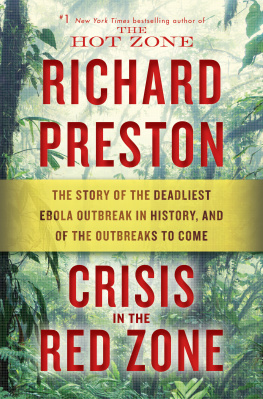Preston - The Hot Zone
Here you can read online Preston - The Hot Zone full text of the book (entire story) in english for free. Download pdf and epub, get meaning, cover and reviews about this ebook. City: Africa;Virginia;Reston, year: 1995, publisher: Anchor Books, genre: Detective and thriller. Description of the work, (preface) as well as reviews are available. Best literature library LitArk.com created for fans of good reading and offers a wide selection of genres:
Romance novel
Science fiction
Adventure
Detective
Science
History
Home and family
Prose
Art
Politics
Computer
Non-fiction
Religion
Business
Children
Humor
Choose a favorite category and find really read worthwhile books. Enjoy immersion in the world of imagination, feel the emotions of the characters or learn something new for yourself, make an fascinating discovery.
- Book:The Hot Zone
- Author:
- Publisher:Anchor Books
- Genre:
- Year:1995
- City:Africa;Virginia;Reston
- Rating:5 / 5
- Favourites:Add to favourites
- Your mark:
- 100
- 1
- 2
- 3
- 4
- 5
The Hot Zone: summary, description and annotation
We offer to read an annotation, description, summary or preface (depends on what the author of the book "The Hot Zone" wrote himself). If you haven't found the necessary information about the book — write in the comments, we will try to find it.
Preston: author's other books
Who wrote The Hot Zone? Find out the surname, the name of the author of the book and a list of all author's works by series.
The Hot Zone — read online for free the complete book (whole text) full work
Below is the text of the book, divided by pages. System saving the place of the last page read, allows you to conveniently read the book "The Hot Zone" online for free, without having to search again every time where you left off. Put a bookmark, and you can go to the page where you finished reading at any time.
Font size:
Interval:
Bookmark:
THE HOT ZONE
Richard Preston Random House ISBN 0-679-43094-6
This book describes events between 1967 and 1993. The incubation period of the viruses in this book is less than twenty-four days. No one who suffered from any of the viruses or who was in contact with anyone suffering from them can catch or spread the viruses outside of the incubation period. None of the living people referred to in this book suffer from a contagious disease. The viruses cannot survive independently for more than ten days unless the viruses are preserved and frozen with special procedures and laboratory equipment. Thus none of the locations in Reston or the Washington, D.C. area described in this book is infective or dangerous.
The second angel poured his bowl into the sea, and it became like the blood of a dead man. -APOCALYPSE
PART ONE THE SHADOW OF MOUNT ELGON
SOMETHING IN THE FOREST
1980 NEW YEAR'S DAY
CHARLES MONET was a loner. He was a Frenchman who lived by himself in a little wooden bungalow on the private lands of Nzoia Sugar Factory, a plantation in western Kenya what spread along the Nzoia River within sight of Mount Elgon, a huge, solitary extinct volcano that rises to a height of fourteen thousand feet near the edge of the Rift Valley. Monet's history is a little obscure. As with so many expatriates who end up in Africa, it is not clear what brought him there. Perhaps he had been in some kind of trouble in France, or perhaps he had been drawn to Kenya by the beauty of the country. He was an amateur naturalist, fond of birds and animals but not of humanity in general. He was fifty-six years old, of medium height and medium build, with smooth, straight brown hair, a good-looking man. It seems that his only close friends were women who lived in towns around the mountain, yet even they could not recall much about him for the doctors who investigated his death. His job was to take care of the sugar factory's water-pumping machinery, which drew water from the Nzoia River and delivered it to many miles of sugar-cane fields. They say that he spent most of his day inside the pump house by the river, as if it pleased him to watch and listen to machines doing their work. So often in a case like this, it's hard to pin down the details. The doctors remember the clinical signs, because no one who has seen the effects of a Biosafety Level 4 hot agent on a human being can ever forget them, but the effects pile up, one after the other, until they obliterate the person beneath them. The case of Charles Monet emerges in a cold geometry of clinical fact mixed with flashes of horror so brilliant and disturbing that we draw back and blink, as if we are staring into a discolored alien sun. Monet came into the country in the summer of 1979, around the time that human immunodeficiency virus, or HIV, which causes AIDS, made a final breakout from the rain forest of central Africa and began its long burn through the human race. AIDS had already fallen like a shadow over the population, although no one yet knew it existed. It had been spreading quietly along the Kinshasa Highway, a transcontinental road that wanders across Africa from east to west and passes along the shores of Lake Victoria within sight of Mount Elgon. HIV is a highly lethal but not very infective Biosafety Level 2 agent. It does not travel easily from person to person, and it does not travel through the air. You don't need to wear a biological suit while handling blood infected with HIV. Monet worked hard in the pump house during the week, and on his weekends and holidays he would visit forested areas near the sugar factory. He would bring food with him, and he would scatter it around and watch while birds and animals ate it. He could sit in perfect stillness while he observed an animal. People who knew him recalled that he was affectionate with wild monkeys, that he had a special way with them. They said that he would sit holding a piece of food while a monkey approached him, and the animal would eat from his hand. On the evenings, he kept to himself in his bungalow. He had a housekeeper, a woman named Johnnie, who cleaned up and prepared his meals. He was teaching himself how to identify African birds. A colony of weaverbirds lived in a tree near his house, and he spent time watching them build and maintain their baglike nests. They say that one day near Christmas he carried a sick bird into his house, where it died, perhaps in his hands. The bird may have been a weaverbird--no one knows--and it may have died of a Level 4 virus--no one knows. He also had a friendship with a crow. It was a pied crow, a black-and-white bird that people in Africa sometimes make into a pet. This crow was a friendly, intelligent bird that liked to peek on the roof of Monet's bungalow and watch his comings and goings. When the crow was hungry, it would land on the veranda and walk indoors, and Monet would feed it scraps of food from his table. He walked to work every morning through the cane fields, a journey of two miles. That Christmas season, the workers had been burning the fields, and so the fields were scorched and black. To the north across the charred landscape, twenty-five miles away, he could see Mount Elgon. The mountain displayed a constantly changing face of weather and shadow, rain and sun, a spectacle of African light. At dawn, Mount Elgon appeared as a slumped pile of gray ridges receding into haze, culminating in a summit with two peaks, which are opposed lips of the eroded cone. As the sun came up, the mountain turned silvery green, the color of the Mount Elgon rain forest, and as the day progressed clouds appeared and hid the mountain from view. Late in the afternoon, near sunset, the clouds thickened and boiled up into an anvil thunderhead that flickered with silent lightning. The bottom of the cloud was the color of charcoal, and the top of the cloud feathered out against the upper air and glowed a dull orange, illuminated by the setting sun, and above the cloud the sky was deep blue and gleamed with a few tropical stars. He had a number of women friends who lived in the town of Eldoret, to the southeast of the mountain, where the people are poor and live in shacks made of boards and metal. He gave money to his women friends, and they, in return, were happy to love him. When his Christmas vacation arrived, he formed a plan to go camping on Mount Elgon, and he invited one of the women from Eldoret to accompany him. No one seems to remember her name. Monet and his friend drove in a Land Rover up the long, straight red-dirt road that leads to Endebess Bluff, a prominent cliff on the eastern side the volcano. The road was volcanic dust, as red as dried blood. They climbed onto the lower skirts of the volcano and went through cornfields and coffee plantations, which gave way to grazing land, and the road passed old, half-ruined English colonial farms hidden behind lines of blue-gum trees. The air grew cool as they went higher, and crested eagles flapped out of cedar trees. Not many tourists visit Mount Elgon, so Monet and his friend were probably the only vehicle on the road, although there would have been crowds of people walking on foot, villagers who cultivate small farms on the lower slopes of the mountain. They approached the frayed outer edge of the Mount Elgon rain forest, passing by fingers and islands of trees, and they passed the Mount Elgon Lodge, an English inn built in the earlier part of century, now falling into disrepair, its walls cracked and its paint peeling off in the sun and rain. Mount Elgon straddles the border between Uganda and Kenya and is not far from Sudan. The mountain is a biological island of rain forest in the center of Africa, an isolated world rising above dry plains, fifty miles across, blanketed with trees, bamboo, and alpine moor. It is a knob in the backbone of central Africa. The volcano grew up seven to ten million years ago, producing fierce eruptions and explosions of ash, which repeatedly wiped out the forests that grew on its slopes, until it attained a tremendous height. Before Mount Elgon was eroded down, it may have been the highest mountain in Africa, higher than Kilmanjaro is today. It is still the widest. When the sun rises, it throws the shadow of Mount Elgon westward and deep into Uganda, and when the sun sets, the shadow reaches eastward across Kenya. Within the shadow of Mount Elgon lie villages and cities inhabited by various tribal groups, including the Elgon Masai, a pastoral people who came from the north and settled around the mountain some centuries ago, and who raise cattle. The lower slopes of the mountain are washed with gentle rains, and the air remains cool and fresh all year, and the volcanic soil produces rich crops of corn. The villages form a ring of human settlement around the volcano, and the ring is steadily closing around the forest on its slopes, a noose that is tangling the wild habitat of the mountain. The forest is being cleared away, the trees are being cut down for firewood or to make room for grazing land, and the elephant are vanishing. A small part of Mount Elgon is a national park. Monet and his friend stopped at the park gate to pay their entrance fees. A monkey or perhaps a baboon--no one seems to remember--used to hang out around the gate, looking for handouts, and Monet enticed the animal to sit on his shoulder by offering it a banana. His friend laughed, but they stayed perfectly still while the animal ate. They drove a short way up the mountain and pitched their tent in a clearing of moist green grass that sloped down to a stream. The stream gurgled out of the rain forest, and it was a strange color, milky with volcanic dust. The grass was kept short by Cape buffalo grazing it, and was spotted with their dung. The Elgon forest towered around their campsite, a web of gnarled African olive trees hung with moss and creepers and dotted with a black olive that is poisonous to humans. They heard a scuffle of monkeys feeding in the trees, a hum of insects, an occasional low huh-huh call of a monkey. They were colobus monkeys, and sometimes one would come down from a tree and scuttle across the meadow near the tent, watching them with alert, intelligent eyes. Flocks of olive pigeons burst from the trees on swift downward slants, flying at terrific speed, which is their strategy to escape from harrier hawks that can dive on them and rip them apart on the wing. There were camphor trees and teaks and African cedars and red stinkwood trees, and here and there a dark green cloud of leaves mushroomed above the forest canopy. These were the crowns of podocarpus trees, or podos, the largest trees in Africa, nearly as large as California sequoias. Thousands of elephants lived on the mountain then, and they could be heard moving through forest, making cracking sounds as they peeled bark and broke limbs from trees. In the afternoon, it would have rained, as it usually does on Mount Elgon, and so Monet and his friend would have stayed in their tent, and perhaps they made love while a thunderstorm hammered the canvas. It grew dark; the rain tapered off. They built a fire and cooked a meal. It was New Year's Eve. Perhaps they celebrated, drinking champagne. The clouds would have cleared off in a few hours, as they usually do, and the volcano would have emerged as a black shadow under the Milky Way. Perhaps Monet stood on the grass at the stroke of midnight and looked at the stars--neck bent backward, unsteady on his feet from the champagne. On New Year's morning, sometime after breakfast--a cold morning, air temperature in the forties, the grass wet and cold--they drove up the mountain along a muddy track and parked in a small valley below Kitum Cave. They bushwhacked up the valley, following elephant trails that meandered besides a little stream that ran through stands of olive trees and grassy meadows. They kept an eye out for Cape buffalo, a dangerous animal to encounter in the forest. The cave opened at the head of the valley, and the stream cascaded over its mouth. The elephant trails joined at the entrance and headed inside. Monet and his friend spent the whole of New Year's Day there. It probably rained, and so they would have sat in the entrance for hours while the little stream poured down in a veil. Looking across the valley, they watched for elephants, and they saw rock hyraxes--furry animals the size of groundhogs--running up and down the boulders near the mouth of the cave. Herds of elephants go inside Kitum Cave at night to obtain minerals and salts. On the plains, it is easy for elephants to find salt in hardpans and dry water holes, but in the rain forest salt is precious thing. The cave is large enough to hold as many as seventy elephant at a time. They spend the night inside the cave, dozing on their feet or mining the rock with their tusks. They pry and gouge rocks off the walls, and chew them to fragments between their teeth, and swallow the broken bits of rock. Elephant dung around the cave is full of crumbled rock. Monet and his friend had a flashlight, and they walked back into the cave to see where it went. The mouth of the cave is huge--fifty-five yards wide--and it opens out even wider beyond the entrance. They crossed a platform covered with powdery dry elephant dung, their feet kicking up puffs of dust as they advanced. The light grew dim, and the floor of the cave rose upward in a series of shelves coated with green slime. The slime was bat guano, digested vegetable matter that had been excreted by a colony of fruit bats on the ceiling. Bats whirred out of holes and flicked through their flashlight beams, dodging around their heads, making high-pitched cries. Their flashlights disturbed the bats, and more bats woke up. Hundreds of bat eyes, like red jewels, looked down on them from the ceiling of the cave. Waves of bat sound rippled across the ceiling and echoed back and forth, a dry, squeaky sound, like many small doors being opened on dry hinges. Then they saw the most wonderful thing about Kitum Cave. The cave is petrified rain forest. Mineralized logs stuck out of the walls and ceiling. They were trunks of rain-forest trees turned to stone--teaks, podo trees, evergreens. An eruption of Mount Elgon about seven million years ago had buried the rain forest in ash, and the logs had been tranformed into opal and chert. The logs were surrounded by crystals, white needles of minerals that had grown out of the rock. The crystals were as sharp as hypodermic syringes, and they glittered in the beams of the flashlights. Monet and his friend wandered through the cave, shining their lights on the petrified rain forest. Did he run his hands over the stone trees and prick his finger on a crystal? They found petrified bones of ancient hippos and ancestors of elephants. There were spiders hanging in webs among the logs. The spiders were eating moths and insects. They came to a gentle rise, where the main chamber widened to more than a hundred yards across--wider than the length of a football field. They found a crevice and shined their lights down to the bottom. There was something strange down there--a mass of gray and brownish material. It was the mummified corpses of baby elephants. When elephants walk through the cave at night, they navigate by their sense of touch, probing the floor ahead of them with the tips of their trunks. The babies sometimes fall into the crevice. Monet and his friend continued deeper into the cave, descending a slope, until they came to a pillar that seemed to support the roof. The pillar was scored with hatch marks and grooves, the marks of elephant tusks. If the elephants continued to dig away at the base of the pillar, it might eventually collapse, bringing down the roof of Kitum Cave with it. At the back of the cave, they found another pillar. This one was broken. Over it hung a velvety mass of bats, which had fouled the pillar with black guano--a different kind of guano from the green slime near the mouth of the cave. These bats were insect eaters, and the guano was an ooze of digested insects. Did Monet put his hand in the ooze? Monet's friend dropped out of sight for several years after that trip to Mount Elgon. Then, unexpectedly, she surfaced in a bar in Mombasa, where she was working as a prostitute. A Kenyan doctor who had investigated the Monet case happened to be drinking a beer in the bar, and he struck up an idle conversation with her and mentioned Monet's name. He was stunned when she said, "I know about that. I come from western Kenya. I was the woman with Charles Monet." He didn't believe her, but she told him the story in enough detail that he became convinced she was telling the truth. She vanished after that meeting in the bar, lost in the warrens of Mombasa, and by now she has probably died of AIDS. Charles Monet returned to his job at the pump house at the sugar factory. He walked to work each day across the burned cane fields, no doubt admiring the view of Mount Elgon, and when the mountain was buried in clouds, perhaps he could still feel its pull, like the gravity of an invisible planet. Meanwhile, something was making copies of itself inside Monet. A life form had acquired Charles Monet as a host, and it was replicating.
Next pageFont size:
Interval:
Bookmark:
Similar books «The Hot Zone»
Look at similar books to The Hot Zone. We have selected literature similar in name and meaning in the hope of providing readers with more options to find new, interesting, not yet read works.
Discussion, reviews of the book The Hot Zone and just readers' own opinions. Leave your comments, write what you think about the work, its meaning or the main characters. Specify what exactly you liked and what you didn't like, and why you think so.

